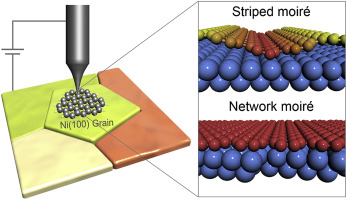Our official English website, www.x-mol.net, welcomes your feedback! (Note: you will need to create a separate account there.)
Graphene on nickel (100) micrograins: Modulating the interface interaction by extended moiré superstructures
Carbon ( IF 10.9 ) Pub Date : 2018-04-01 , DOI: 10.1016/j.carbon.2018.01.010 Zhiyu Zou , Virginia Carnevali , Matteo Jugovac , Laerte L. Patera , Alessandro Sala , Mirco Panighel , Cinzia Cepek , German Soldano , Marcelo M. Mariscal , Maria Peressi , Giovanni Comelli , Cristina Africh
Carbon ( IF 10.9 ) Pub Date : 2018-04-01 , DOI: 10.1016/j.carbon.2018.01.010 Zhiyu Zou , Virginia Carnevali , Matteo Jugovac , Laerte L. Patera , Alessandro Sala , Mirco Panighel , Cinzia Cepek , German Soldano , Marcelo M. Mariscal , Maria Peressi , Giovanni Comelli , Cristina Africh

|
Abstract Interaction with the substrate strongly affects the electronic/chemical properties of supported graphene. So far, graphene grown by chemical vapor deposition (CVD) on catalytic single crystal transition metal surfaces - mostly 3-fold close-packed - has mainly been studied. Herein, we investigated CVD graphene on a polycrystalline nickel (Ni) substrate, focusing in particular on (100) micrograins and comparing the observed behavior with that on single crystal Ni(100) substrate. The symmetry-mismatch leads to moire superstructures with stripe-like or rhombic-network morphology, which were characterized by atomically-resolved scanning tunneling microscopy (STM). Density functional theory (DFT) simulations shed light on spatial corrugation and interfacial interactions: depending on the misorientation angle, graphene is either alternately physi- and chemisorbed or uniformly chemisorbed, the interaction being modulated by the (sub)nanometer-sized moire superstructures. Ni(100) micrograins appear to be a promising substrate to finely tailor the electronic properties of graphene at the nanoscale, with relevant perspective applications in electronics and catalysis.
中文翻译:

镍 (100) 微晶上的石墨烯:通过扩展莫尔超结构调节界面相互作用
摘要 与基材的相互作用强烈影响负载石墨烯的电子/化学性质。到目前为止,主要研究了通过化学气相沉积(CVD)在催化单晶过渡金属表面(主要是 3 倍密堆积)上生长的石墨烯。在此,我们研究了多晶镍 (Ni) 衬底上的 CVD 石墨烯,特别关注 (100) 微晶粒并将观察到的行为与单晶 Ni(100) 衬底上的行为进行比较。对称性不匹配导致具有条纹状或菱形网络形态的莫尔超结构,其特征在于原子分辨扫描隧道显微镜 (STM)。密度泛函理论 (DFT) 模拟揭示了空间波纹和界面相互作用:取决于错误取向的角度,石墨烯被交替物理和化学吸附或均匀化学吸附,相互作用由(亚)纳米级莫尔超结构调节。Ni(100) 微粒似乎是一种很有前途的基材,可以在纳米尺度上精细调整石墨烯的电子特性,在电子和催化方面具有相关的前景应用。
更新日期:2018-04-01
中文翻译:

镍 (100) 微晶上的石墨烯:通过扩展莫尔超结构调节界面相互作用
摘要 与基材的相互作用强烈影响负载石墨烯的电子/化学性质。到目前为止,主要研究了通过化学气相沉积(CVD)在催化单晶过渡金属表面(主要是 3 倍密堆积)上生长的石墨烯。在此,我们研究了多晶镍 (Ni) 衬底上的 CVD 石墨烯,特别关注 (100) 微晶粒并将观察到的行为与单晶 Ni(100) 衬底上的行为进行比较。对称性不匹配导致具有条纹状或菱形网络形态的莫尔超结构,其特征在于原子分辨扫描隧道显微镜 (STM)。密度泛函理论 (DFT) 模拟揭示了空间波纹和界面相互作用:取决于错误取向的角度,石墨烯被交替物理和化学吸附或均匀化学吸附,相互作用由(亚)纳米级莫尔超结构调节。Ni(100) 微粒似乎是一种很有前途的基材,可以在纳米尺度上精细调整石墨烯的电子特性,在电子和催化方面具有相关的前景应用。


























 京公网安备 11010802027423号
京公网安备 11010802027423号